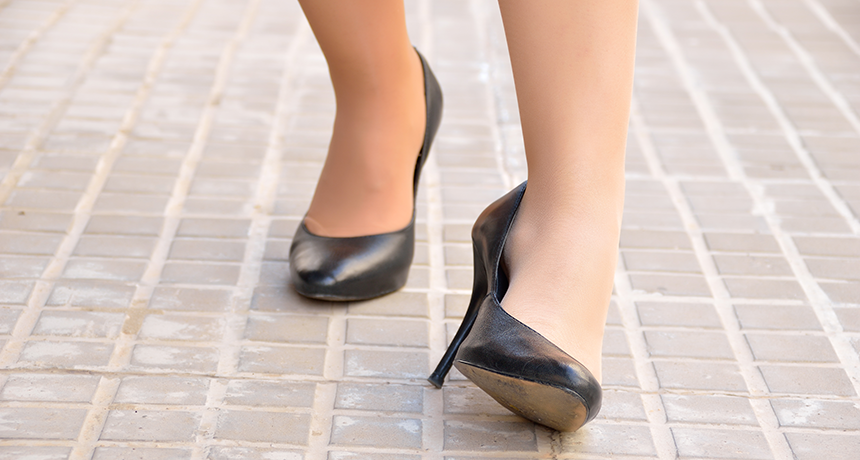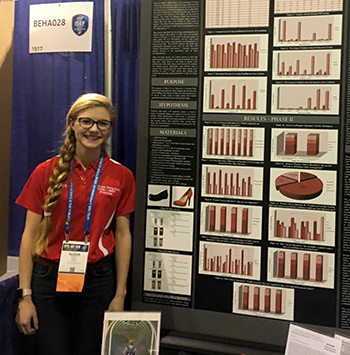Many women take unnecessary risks with sky-high heels
A teen took her love of fashion to science and turned up a few surprises

High heels can make women lose their balance more easily. But many women wear them because they mistakenly think men find them attractive, a teen’s research shows.
Manuel-F-O/iStockphoto
PITTSBURGH, Pa. — For many people, slipping a pair of high heels on is just part of getting dressed up for work or going out. High heels can make someone feel more attractive or confident, notes Alexis McFeely. This16-year-old speaks from experience. But after her grandmother took a nasty fall, the teen began to question the safety of her favorite shoe. So this sophomore at St. John Paul II Catholic High School in Huntsville, Ala., decided to do some research. And her findings surprised even her.
High heels are not only bad for balance, she showed, but they also do not make women as attractive as they seem to think.
Alexis brought her findings to the Intel International Science and Engineering Fair. This yearly event was created and is run by Society for Science & the Public. It brought together almost 1,800 students from 81 countries to share their science fair projects. This year, ISEF is sponsored by Intel. (The Society also publishes Science News for Students and this blog.)
Prompted by her grandmother’s fall, Alexis contacted the center where her grandmother was seeing a therapist to improve her balance. She arranged to use a machine there that measures postural stability — the ability to maintain balance. As a patient stands in a harness, the foot area below them tilts and moves. A computer measures how quickly and how well patients can adjust their posture to maintain their balance.
The teen recruited 25 women for tests on the machine. Each underwent 18 tests — half wearing flats, the rest of the time standing in shoes with heels that were 7.6 centimeters (3 inches) high. To make this test scientific, each woman had to be compared to the others while wearing the same shoes. Since the women varied in size and age, Alexis had to buy a lot of matching flats and high heels.
No surprise, the women did not balance as well in the high heels as they did wearing flats. The average drop-off in balance when wearing heels was 9.4 percent, she reports. It’s enough, Alexis says, to potentially make the difference “between falling or not.”
And some women did fall as the platform beneath them shifted. Three of her participants fell in flats, while 14 fell off their high heels.
Her recruits ranged in age from 14 to more than 65 years old. The older women fell the most often. Again, that’s hardly a surprise as these women, she notes “started off with a lower balance score.”
A stiletto survey
“I’ve always thought I’m more attractive in high heels,” Alexis says. She adds that she had also “assumed guys would think I was more attractive [in them].” But to be sure, she went back to science for some answers.
The teen designed two surveys — one for men, the other for women. Both groups looked at photos of a woman. In one she wore flats. The other showed her standing in in heels while wearing the same outfit. The survey then asked people which image they preferred.

To get lots of recruits, Alexis put her survey on Facebook. She also included a link to it on her Instagram account. At the local airport, she handed out the survey to people as they walked by the ticket counters. In the end, 225 women and 208 men took part.
Women clearly preferred the photo of a woman in heels. But to her surprise, the teen found that “almost half of the men didn’t see a difference between the pictures.”
That wasn’t the only surprise. The women’s survey had asked females if they thought high heels made them more attractive. It also asked women how secure they felt wearing heels. Alexis asked the men whether they found women more attractive in high heels and if they’d like their partner to wear them.
Two in every three women surveyed — 66 percent — reported feeling off balance when they wore high heels. Nearly as many women — 62 percent — also said they thought men preferred them in high heels. In fact, only one in three men did. The rest said they preferred women to wear flats. (Only one in every four men had said they’d prefer their significant other to wear high heels.)
“It shows that women are making themselves feel unsafe because they feel they are more attractive in high heels,” Alexis concludes.
The teen hopes her findings might help inform people about risks from high heels — especially older women who might not have good balance. “My grandmother didn’t know that she was 13 times more likely to fall,” she says. “If she did, she wouldn’t have been wearing them.”
“I love high heels and I’ve been wearing them for a while now,” Alexis notes. And even after her science project, she has no plans to give them up. Being young and having no balance problems, she notes, “I’m good to go.” However, she adds, “Knowing now that men don’t have a preference, I feel less pressure [to wear them].”







